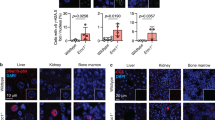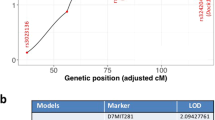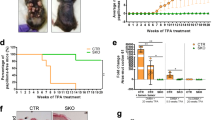Abstract
DNA damage may mediate birth defects caused by many drugs and environmental chemicals, therefore p53, a tumour suppressor gene that facilitates DNA repair, may be critically embryoprotective. We have studied the effects of the environmental teratogen, benzo[a]pyrene, on pregnant heterozygous p53–deficient mice. Such mice exhibited between 2– to 4–fold higher embryotoxicity and teratogenicity than normal p53–controls. Fetal resorptions reflecting in utero death were genotyped using the polymerase chain reaction and found to be increased 2.6–fold and 3.6–fold respectively with heterozygous and homozygous p53–deficient embryos. These results provide the first direct evidence that p53 may be an important teratological suppressor gene which protects the embryo from DNA–damaging chemicals and developmental oxidative stress.
This is a preview of subscription content, access via your institution
Access options
Subscribe to this journal
Receive 12 print issues and online access
$209.00 per year
only $17.42 per issue
Buy this article
- Purchase on Springer Link
- Instant access to full article PDF
Prices may be subject to local taxes which are calculated during checkout
Similar content being viewed by others
References
Manson, J.M. Developmental toxicity of alkylating agents: mechanism of action. In The Biochemical Basis of Chemical Teratogenesis. (ed Juchau, M.R.) 95–136 (Elsevier, New York, 1980).
Kastan, M.B., Onyekwere, O., Sidransky, D., Vogelstein, B. & Craig, R.W. Participation of p53 protein in the cellular response to DMA damage. Cancer Res. 51, 6304–6311 (1991).
Lowe, S.W., Schmitt, E.M., Smith, S.W., Osborne, B.A. & Jacks, T. p53 is required for radiation-induced apoptosis in mouse thymocytes. Nature 362, 847–849 (1993).
Clarke, A.R. et al. Thymocyte apoptosis induced by p53-dependent and independent pathways. Nature 362, 849–852 (1993).
Merritt, A.J. et al. The role of p53 in spontaneous and radiation-induced apoptosis in the gastrointestinal tract of normal and p53-deficient mice. Cancer Res. 54, 614–617 (1994).
Hollstein, M., Sidransky, D., Vogelstein, B. & Harris, C.C. p53 mutations in human cancers. Science 253, 49–53 (1991).
Malkin, D. et al. Germ line p53 mutations in a familial syndrome of breast cancer, sarcomas, and other neoplasms. Science 250, 1233–1238 (1990).
Srivastava, S., Zou, Z.Q., Pirollo, K., Blattner, W. & Chang, E.H. Germ line transmission of a mutated p53 gene in a cancer-prone family with Li-Fraumeni syndrome. Nature 348, 747–749 (1990).
Donehower, L.A. et al. Mice deficient for p53 are developmental normal but susceptible to spontaneous tumours. Nature 356, 215–221 (1992).
Harvey, M. et al. Spontaneous and carcinogen-induced tumorigenesis in p53-deficient mice. Nature Genet. 5, 225–229 (1993).
Fritsche, M., Haessler, C. & Brandner, G. Induction of nuclear accumulation of the tumour-suppressor protein p53 by DMA-damaging agents. Oncogene 8, 307–318 (1993).
Zhan, Q., Carrier, F. & Fornace, A.J., Induction of cellular p53 activity by DMA-damaging agents and growth arrest. Molec. cell. Biol. 13, 4242–4250 (1993).
Schmid, P., Lorenz, A., Hameister, H. & Montenarh, M. Expression of p53 during mouse embryogenesis. Development 113, 857–865 (1991).
Louis, J.M., Mcfarland, V.W., May, P. & Mora, P.T. The phosphoprotein p53 is down-regulated post-transcriptionally during embryogenesis in vertebrates. Biochim. biophys. Acta 950, 395–402 (1988).
Phillips, D.H. Fifty years of B[a]P. Nature 303, 468–472 (1983).
Shum, S., Jensen, N.M. & Nebert, D.W. The murine Ah locus: in utero toxicity and teratogenesis associated with genetic differences in benzo[a]pyrene metabolism. Teratology 20, 365–376 (1979).
Gelboin, H.V., tabolism, activation, and carcinogenesis: Role and regulation of mixed function oxidases and related enzymes. Physiol. Rev. 60, 1107–1166 (1980).
Mamett, L.J., Reed, G.A. & Dennison, D.J. Prostaglandinsynthasedependent activation of 7,8-dihydro-7,8-dihydroxybenzo[a]pyrene to mutagenic derivatives. Biochem. biophys. Res. Commun. 82, 210–216 (1978).
Wrighton, S.A. & Stevens, J.C. The human hepatic cytochromes P-450 involved in drug metabolism. Crit. Rev. Toxicol. 22, 1–21 (1992).
Okey, A.B., Riddick, D.S. & Harper, P.A. Molecular biology of the aromatic hydrocarbon (dioxin) receptor. Trends pharmacol. Sci. 15, 226–232 (1994).
Shen, E.S., Guengerich, F.P. & Olson, J.R. Biphasic response for hepatic microsomal enzyme induction by 2,3,7,8-tetrachlorodibenzodioxin in C57BL/6J and DBA/2J mice. Biochem. Pharmcol. 38, 4075–4084 (1989).
Van den berg, M., De Jongh, J., Poiger, H. & Olson, J.R. The toxicokinetics and metabolism of polychlorinated dibenzo-p-dioxins (PCDDs) and dibenzofurans (PCDFs) and their relevance for toxicity. Crit. Rev. Toxicol. 24, 1–74 (1994).
Birnbaum, L.S., Weber, H., Harris, M.W., Lamb, J.C. IV. & McKinney, J.D. Toxic interaction of specific polychlorinated biphenyls and 2,3,7,8-tetrachlorodibenzo-p-dioxin: increased incidence of cleft palates in mice. Toxicol. appl. Pharmacol. 77, 292–302 (1985).
Burke, M.D. et al. Ethoxy-, pentoxy- and benzyloxyphenoxazones and homologues: a series of substrates to distinguish between different induced cytochromes P-450. Biochem. Pharmacol. 34, 3337–3345 (1985).
Jones, K.L. & Smith, D.W. The fetal alcohol syndrome. Teratology 12, 1–10 (1975).
Hanson, J.W. & Smith, D.W. The fetal hydantoin syndrome. J. Pediatr. 87, 285–290 (1975).
Finnell, R.H. & Chernoff, G.F. Variable patterns of malformation in the mouse fetal hydantoin syndrome. Am. J. med. Genet. 19, 463–471 (1984).
Strickler, S.M. et al. Genetic predisposition to phenytoin induced birth defects. Lancet 2, 746–749 (1985).
Scolnik, D. et al. Neurodevelopment of children exposed in utero to phenytoin and carbamazapine monotherapy. J. Am. med. Assoc. 271, 767–770 (1994).
Sands, A., Donehower, L.A. & Bradley, A. Gene-targeting and the p53 tumour-suppressor gene. Mutat. Res. 307, 557–572 (1994).
Jacks, T. et al. Tumor spectrum analysis in p53 mutant mice. Curr. Biol. 4, 1–7 (1994).
Purdie, C.A. et al. Tumour incidence, spectrum and ploidy in mice with a large deletion in the p53 gene. Oncogene 9, 603–609 (1994).
Sah, V.P. et al. A subset of p53-deficient embryos exhibit exencephaly. Nature Genet. 10, XXX–YYY (1995).
Winn, L.M. & Wells, P.G. Phenytoin-initiated DMA oxidation in murine embryo culture, and embryoprotection by the antioxidative enzymes superoxide dismutase and catalase: Evidence for reactive oxygen species-mediated DMA oxidation in the molecular mechanism of phenytoin teratogenicity. Mol. Pharmacol. (in the press).
Liu, L. & Wells, P.G. DMA oxidation as a potential molecular mechanism mediating drug-induced birth defects: Phenytoin and structurally related teratogens initiate the formation of 8-hydroxy-2′-deoxyguanosine in vitro and in vivo in murine maternal hepatic and embryonic tissues. Free Rad. Biol. Med. (in the press).
Kastan, M.B. et al. A mammalian cell cycle checkpoint pathway utilizing p53 and GADD45 is defective in ataxia-telangiectasia. Cell 71, 587–597 (1992).
Cleaver, J.E. It was a very good year for DMA repair. Cell 76, 1–4 (1994).
McWhir, J., Selfridge, J., Harrison, D.J., Squires, S. & Melton, D.W. Mice with DMA repair gene (ERCC-1) deficiency have elevated levels of p53, liver nuclear abnormalities and die before weaning. Nature Genet. 5, 217–223 (1993).
Jacks, T. et al. Effects of an Rb mutation in the mouse. Nature 359, 295–300 (1992).
Manson, J.M. & Kang, Y.J. Test methods for assessing female reproductive and developmental toxicology. In Principles and Methods of Toxicology, (ed Hayes, A.W.), 3, 989–1037 (Raven Press, New York.1994).
Smart, Y.C., Fraser, I.S., Roberts, T.K., Clancy, R.L. & Cripps, A.W. Fertilization and early pregnancy loss in heathy women attempting conception. Clin. Reproduct. Fertil. 1, 177–184 (1982).
Rolfe, B.E. Detection of fetal wastage. Fertil. Steril. 37, 655–660 (1982).
Roberts, C.J. & Lowe, C.R. Where have all the conceptions gone. Lancet 1, 498–499 (1975).
Gupta, R.C. Nonrandom binding of the carcinogen N-hydroxy-2-acetyl aminofluorene to repetitive sequences of rat liver DNA in vivo. Proc. natl. Acad. Sci. U.S.A. 81, 6943–6947 (1984).
Timme, T.L. & Thompson, C. Rapid allelotype analysis of p53 knockout mice. Benchmarks 17, 461–463 (1994).
Author information
Authors and Affiliations
Rights and permissions
About this article
Cite this article
Nicol, C., Harrison, M., Laposa, R. et al. A teratologic suppressor role for p53 in benzo(a)pyrene–treated transgenic p53-deficient mice. Nat Genet 10, 181–187 (1995). https://doi.org/10.1038/ng0695-181
Received:
Accepted:
Issue Date:
DOI: https://doi.org/10.1038/ng0695-181
This article is cited by
-
Transcriptome dynamics in benzo[a]pyrene exposed Hydra
Molecular & Cellular Toxicology (2022)
-
Deficient DNA repair exacerbates ethanol-initiated DNA oxidation and embryopathies in ogg1 knockout mice: gender risk and protection by a free radical spin trapping agent
Archives of Toxicology (2016)
-
Prenatal exposure to polycyclic aromatic hydrocarbons and cognitive dysfunction in children
Environmental Science and Pollution Research (2015)
-
Identification of differentially expressed genes in liver of marine medaka fish exposed to benzo[a]pyrene
Toxicology and Environmental Health Sciences (2011)
-
Teratogen-induced alterations in microRNA-34, microRNA-125b and microRNA-155 expression: correlation with embryonic p53 genotype and limb phenotype
BMC Developmental Biology (2010)



